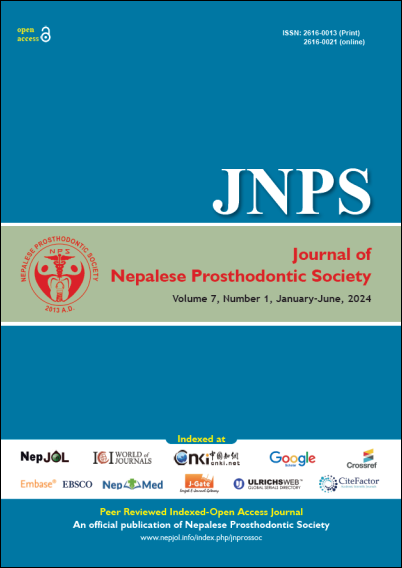Atypical Odontalgia or Phantom Tooth Pain: Current Evidences for Better Understanding, Diagnosis and Management
DOI:
https://doi.org/10.3126/jnprossoc.v7i1.70456Keywords:
Atypical Odontalgia, Central sensitization, Deafferentation Syndrome, Endodontic Treatment, Peripheral Sensitization, Phantom Tooth Pain, Psychiatric componentsAbstract
The phantom tooth pain or Atypical Odontalgia (AO) is a persistent orofacial pain disorder affecting teeth or tooth sockets after dental treatments like root canal therapy or extractions even when there is no any identifiable cause on clinical or radiographic examination. These conditions are thought to be associated with neuropathic, vascular or psychiatric disorders along with comorbid factors like temporomandibular joint dysfunction syndrome, burning mouth syndrome, various types of headaches etc. Peripheral and central sensitization has been considered as a possible pathophysiology of such conditions in denervated teeth and extraction sites. The pain usually radiates from the differentiation sites to the adjacent structures. These conditions usually get undiagnosed and in most of the scenario, dentists only consider a diagnosis only after failure of multiple invasive treatments and worsening of the symptoms. Although, it is very crucial to establish a diagnostic criteria and treatment regimen for AO, still evidences are confusing and lots of clinicians are still unaware of the condition. Hence, this article reviews on AO, its terminologies, prevalence, chief complain, clinical features, pathophysiology, comorbidities, diagnostic work out, and pharmacological treatment modalities with the aim of describing the clinical characteristics, possible cause and treatment modalities. This will definitely aid in an accurate diagnosis of the conditions, before treatments are initiated to avoid overtreatments in such conditions.
Downloads
Downloads
Published
How to Cite
Issue
Section
License
Copyright (c) 2024 The Author(s)

This work is licensed under a Creative Commons Attribution-NonCommercial-NoDerivatives 4.0 International License.
This license enables reusers to distribute, remix, adapt, and build upon the material in any medium or format, so long as attribution is given to the creator. The license allows for commercial use. © The authors




